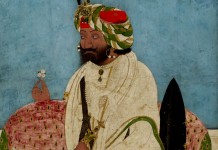Shamas Faqir(شمس فقیر in Kashmiri)
He is one of the most famous Sufi poet of Kashmir. He was born Mohammad Sidiq Bhat in Chinkral Mohalla neighborhood of Srinagar, Kashmir in 1843. Having been born in a poor family, it is said that he never received any formal education. He however did become an apprentice of Niama Saeb another famous Sufi poet of Kashmir. He became a disciple of many Sufi Saints, among them were Souch Maliar, Abdul Rehman of Burzalla, Atiq-Ullah of Gulab Bagh, Mohammad Jammal and Rasool Saeb.
Shamas Faqir belonged to the Qadiriyya silsila of Sufism. At age 25 he left for Amritsar, in Indian Punjab where he became a disciple of another Sufi Saint. After his return from Amritsar he decided to live in Anantnag, Kashmir, where he got married. He came back to his ancestral home in Srinagar for some time. He then meditated for six months in a cave at Qazi Bagh in Budgam district of Kashmir.After his meditation, he decided to live in Krishpore, where he died in1901. He is buried at Krishpore. Shamas Faqir had two sons and a daughter. Shamas Faqir speaks of his experience of the inward music of the soul, of the ‘vibrant string within’, that reminds us of anahata (unstrung sound) mentioned in Surat-Sabda Yoga.
A striking feature of Shamas Faqir’s poems is the diction: using largely the Kashmiri idiom current in his time, he also employs words from Persian, Arabic and Sanskrit. He can bend language to his needs, blending harmoniously words from diverse sources together – an achievement creative in a high degree. In some poems particularly, we notice that he makes a consistent use of terms (and related concepts) derived from the Hindu Sastras (including both Vedanta and Saiva texts) with remarkable ease and facility.
As examples we may mention terms like zagrat (wakefulness), sopan (dream), sushapt (deep sleep), turya (superconsciousness), terms relating to the four elements including pavan (air) and akasa (ether), words like soham (He am I), sunya (void), rav (the sun), shiv (Siva), anand (bliss), om, raza honz (King of swans). He handles the vocabulary and the related concepts so well that the poems acquire a distinctive Hindu tone. Of such poems the one that specially comes to my mind is titled ‘Pad’ (the first of the sequence).
The interfusion of two cultures is indeed very conspicuous in the Sufi poet.
Several lyrics of Shamas Faqir centre round the theme of the mystic’s quest for the primal cause of this universe. As an illustration, the lyric titled ‘Agur Kami Manz Drav’ repeatedly poses the question, ‘what is the fountainhead of the stream?’, which serves as its refrain. Here is my translation of some significant lines of the poem (attempted to convey the essential meaning):
Day and night does Pavan flow
Through the four Bhavans non-stop;
Whence did it come
And whither did it go?
It was even (all of one hue),
Whence did the stream come forth?
…….
He who owns the sea
Is the Lord of water,
The river issued from the drop;
To get to the meaning,
Sacrifice yourself first;
…..
O Shamas, to attain gnosis,
Throw open your heart’s door;
Sun-like, roam the sky through
(To fathom the Secret);
What is the fountain-head?
















